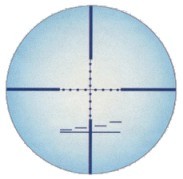
Mil-dot reticles are commonly used by advanced riflemen. This site is pretty much THE place to go for information on Mil-Dot systems and how to use them.
Modern military and law enforcement reticles are generally designed for (stadiametric) rangefinding purposes. Perhaps the most flexible ranging reticle is the "Mil-dot" reticle, which consists of duplex crosshairs with small dots at milliradian (Mil) intervals in the field of view.[8] A milliradian equates to 3.43774677078493 MOA, that is, approximately 21.6 inches at 600 yards; each MOA equates to 1.0471975511966 inch at 100 yards, often rounded to 1 inch at 100 yards for fast mental calculations.
Users who use the metric system are better off with a Mil-dot reticle, since they do not have to hassle with the unnecessary complications of a non metric system of measurement during mental calculations. Also the Mil-dot measurements and ranging calculations are always exact in the metric system.
A trained user can relatively accurately measure the range to objects of known size, the size of objects at known distances, and compensate for both bullet drop and wind drifts at known ranges with a Mil-dot reticle-equipped scope.

This is what a Netherlands Army sniper sees through his Schmidt & Bender 3-12x50 telescopic sight. The Mil-dots can be seen on the cross hairs. By means of a mathematical formula - (width or height of the target/ number of mil of dots) x 1000 = distance - the user can measure the range to a target. An object of 1 meter tall or wide is exactly 1 Mil tall or wide at 1000 meters distance. If the user sees an object of 1.8 m tall for example as three mil dots tall through the riflescope the object is at 600 m distance - (1.8 / 3) x 1000 = 600.
The four horizontal bars over the horizontal line are also intended for (quick) ranging purposes.
If the helmeted head of a man (? 0.25 M tall) fits between the fourth bar and the horizontal line, the man is at approximately 100 meters distance. When the upper part of the body of a man (? 1 M tall) fits under the first line, he stands at approximately 400 meters distance.
(Me)
(Home)







0 comments:
Post a Comment